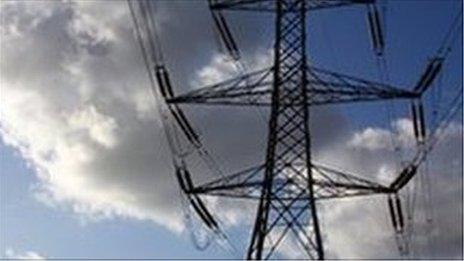North-south electricity interconnector becomes key issue
- Published

The Sheridans describe the pylons as monstrous tombstones
The north-south electricity interconnector is in the news in both the Republic of Ireland and Northern Ireland.
In the Republic, energy company EirGrid has yet to seek planning permission with the Republic of Ireland's planning authorities, An Bord Pleanala.
The issue of overground pylons versus underground cabling has become one that may well feature in this year's local and European elections.
Paula Sheridan and her husband Mike live in Drumree, County Meath, about a 45-minute drive from Dublin.
Both keen gardeners, their house is 50 metres from an electricity pylon.
The wires over their property can carry up to 400,000 volts of electricity and they say the proposed north-south interconnector will double that capacity.

Paula Sheridan said her house is now worthless
Paula describes the nearby pylon as "a monstrous tombstone" hanging over their home.
"What price have we paid for electricity?" she said. "Our house is worthless. We tried to sell it, nobody would buy it. Our health has been destroyed; our children's inheritance is gone. Nobody has considered that in the equation. What price have we paid?"
Paula Sheridan was treated for colo-rectal cancer last year; Mike for prostate cancer three years ago.
And while they accept it cannot be proven that the pylon caused their cancers, Mike believes there is a link.
"Having spent an awful lot of time over the last 30 years out in the garden there, I would make a link between my exposure and the cancer that I had, yeah," he said.
Those opposed to electricity pylons say the metal towers are ugly and ruin the landscape, they lower property prices, but most damning of all, they are a health risk.
But the Irish Minister for Communication, Energy and Natural Resources, Pat Rabbitte, is adamant there is no evidence that overground wires cause cancer.

Pat Rabbitte says there is no evidence that overground wires cause cancer
He said that expert advice from the World Health Organisation suggests there is no reason for health concerns.
"It's a fairly fantastic proposition, to allege that any government or state agency would engage in infrastructural build-out that posed a health risk to people. That really is unconscionable," he said.
The planning appeal process will hear submissions in favour of putting the wires underground - a much more expensive and technically difficult process according to Mr Rabbitte, which is why, he said, more than 95% of cabling is overhead in the developed world.
He also said going underground would put 3% on electricity bills for the next 50 years.
But Colin Andrew, a chartered engineer, a geologist and a member of the North East Pylon Pressure Committee believes the extra cost of putting the cables below the soil, for the two administrations and the two electricity companies, is worth paying.
"There is a better way and all we are requesting is that the governments, north and south, and SOMI in the north and EirGrid in the south, look at the better way, which is acceptable to the communities," he said.

Colin Andrew believes the cost of putting cables underground is worth paying
"We believe the total cost to the average bill-payer of undergrounding the north-south interconnector will be less than 70 cents a month or 50p a month in the north."
Overground or underground has yet to be decided on.
But the need for more electricity is not in doubt, especially for Northern Ireland, according to a senior well-informed source.
Mr Rabbitte said he accepts that people have genuine concerns about the visual impact of pylons and how they affect property prices.
However, he added: "There always has been a trade-off between the comforts of modern civilisation and an element of intrusion into the way we live.
"That's unavoidable if you are going to have electricity supply, mod cons and the power to provide jobs and industry in the regions."
For governments, voters and planners the issue of pylons, it seems, is part of the age-old dilemma - what price progress?
- Published27 March 2014

- Published17 January 2012

- Published19 August 2010